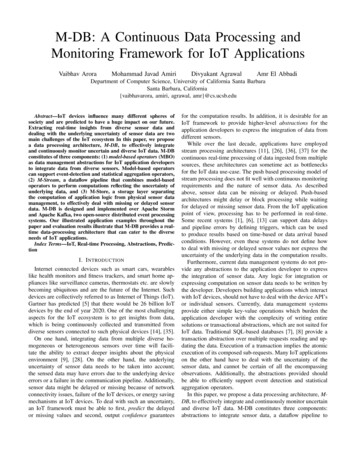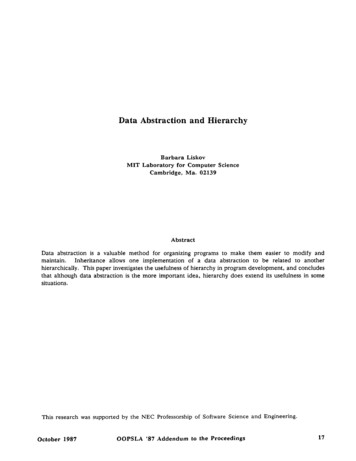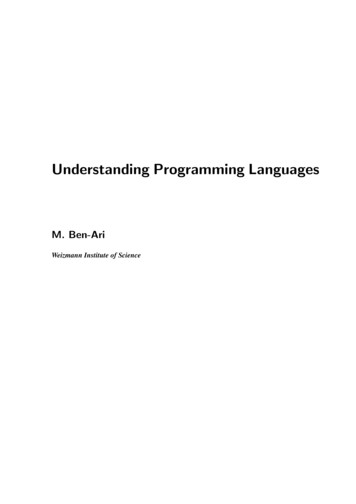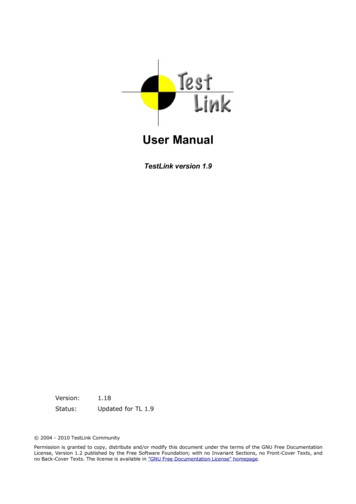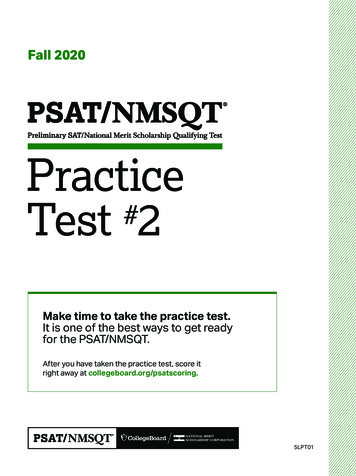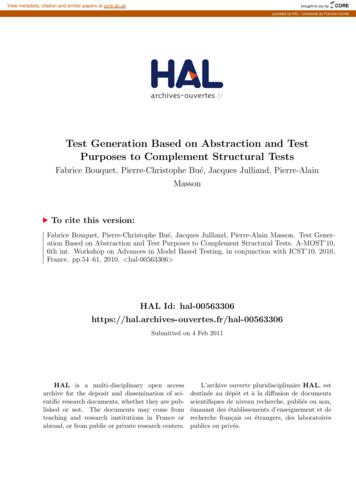
Transcription
View metadata, citation and similar papers at core.ac.ukbrought to you byCOREprovided by HAL - Université de Franche-ComtéTest Generation Based on Abstraction and TestPurposes to Complement Structural TestsFabrice Bouquet, Pierre-Christophe Bué, Jacques Julliand, Pierre-AlainMassonTo cite this version:Fabrice Bouquet, Pierre-Christophe Bué, Jacques Julliand, Pierre-Alain Masson. Test Generation Based on Abstraction and Test Purposes to Complement Structural Tests. A-MOST’10,6th int. Workshop on Advances in Model Based Testing, in conjunction with ICST’10, 2010,France. pp.54–61, 2010. hal-00563306 HAL Id: 0563306Submitted on 4 Feb 2011HAL is a multi-disciplinary open accessarchive for the deposit and dissemination of scientific research documents, whether they are published or not. The documents may come fromteaching and research institutions in France orabroad, or from public or private research centers.L’archive ouverte pluridisciplinaire HAL, estdestinée au dépôt et à la diffusion de documentsscientifiques de niveau recherche, publiés ou non,émanant des établissements d’enseignement et derecherche français ou étrangers, des laboratoirespublics ou privés.
Test Generation Based on Abstraction and TestPurposes to Complement Structural TestsF. Bouquet, P.-C. Bué, J. Julliand, P.-A. MassonLIFC - Université de Franche-Comté - 16, route de Gray F-25030 Besançon Cedex, FranceEmail: {bouquet, bue, julliand, masson}@lifc.univ-fcomte.frAbstract—This paper presents a computer aided model-basedtest generation method. We propose this approach as a complement to the LTG (Leirios Test Generator) method, whichextracts functional tests out of a formal behavioral model Mby means of static (or structural) selection criteria. Our methodcomputes additional tests by applying dynamic (or behavioral)selection criteria (test purposes called TP). Applying TP directlyto M is usually not possible for industrial applications due tothe huge (possibly infinite) size of their state space. We computean abstraction A of M by predicate abstraction. We propose amethod to define a set of abstraction predicates from informationof TP. We generate symbolic tests from A by using TP as adynamic selection criterion. Then we instantiate them on M,which allows us play the tests on the implementation the sameway as we play the functional ones. Our experimental resultsshow that our tests are complementary to the structural ones.Keywords-Model-Based Testing; Abstraction; Test Purpose;I. I NTRODUCTIONModel-Based Testing (MBT) is a test generation approachthat automatically computes, from a behavioral model of asystem and selection criteria, a set of tests to be executed on animplementation of that system (the implementation under test,IUT). There are model based test generation suites available ascommercial products, such as LTG [1] and TD1 , Conformiq2,SpecExplorer [2], or as research prototypes, such as TGV [3]and STG [4], AGATHA [5], etc.Fig. 1.Model-Based Testing ApproachA “standard” MBT approach is illustrated by means ofFig. 1. A model M describes the behavior of the system bymeans of a set of parameterized actions. The test generationtool, depending on selection criteria, instantiates from M a setof tests IT (instantiated tests). The tests in IT are sequences ofaction calls where the input parameters and the correspondingoutputs are instantiated. The tests of IT are as abstract asthe model, so a concretization layer CL translates them intoconcrete tests (CT), that are executed on the IUT. The verdictof success or failure of a test is delivered by comparing theresults returned by the IUT with the ones predicted by M.1 LTGand TD are from Smartesting: http://www.smartesting.comis from Qtronic : http://www.conformiq.com2 ConformiqOne advantage of MBT is to have with the behavioral modelan oracle to predict the outputs of the IUT. Another one is thepossibility to achieve different kinds of coverage of the model(such as state coverage, decision coverage, path coverage)by varying the selection criteria. But writing the behavioralmodel and the concretization layer is costly, and ideally alarge variety of test cases, i.e. achieving a large spectrum ofcoverage, should be computed from them.An MBT tool-supported method, the LTG technology [1],has been developed in our research team and is now commercialized by the Smartesting company. It ensures structuralcoverage of the model by means of static (i.e. structural)selection criteria. Additionally, we intend to generate test casesissued from dynamic selection criteria [6], [7]. A test engineer(the tester) specifies a set of executions that he finds interestingto test by means of a test purpose (TP). The TP is specified ina language [7] that allows the tester to describe which actionsto call and which states to reach. Some of the action calls canbe left unspecified, which provides flexibility to the tester forexpressing his test intention, but requires later these calls tobe made explicit. This is performed by a research amongst thepossible instantiations allowed by the model of the unspecifiedaction calls, and it can possibly blow up with huge size models.We propose in this paper to define, based on informationextracted from the TP, a set of predicates from which wecompute an abstraction A (of small size) of a behavioral modelM. We first compute its synchronized product SP with the TP,and then a set of traces that cover every transition of SP. Eachtrace is a symbolic test for which we search an instantiationon M. This results in a new (w.r.t. the structural ones) set ofinstantiated tests IT, that can be executed on the IUT throughthe same concretization layer.Our contributions are to define the set of abstraction predicates based on information of the TP. This makes the resultingabstraction related to what the tester intends to observe. Also,M provides an oracle for our new tests, and it is reused as wellas the concretization layer to execute the tests on the IUT. Wehave an experimental validation of the method.We detail our process for generating tests from abstractions and test purposes in Sec. II. Section III presents the“Qui-Donc” example that illustrates our approach. We definelabelled transition systems (LTSs, for short) in Sec. IV andgive the syntax of our behavioral models, whose semantics areLTSs. The abstractions and the test purposes are also definedas LTSs in Sec. V, where their synchronized product is defined.
The definition from the TP of a set of abstraction predicates isdetailed in Sec. VI. This set is the basis for the computationof the abstraction, as explained in Sec. VII, where we alsoexplain how to generate symbolic tests out of it. Experimentalresults are presented and discussed in Sec. VIII. Section IXconcludes the paper, compares our approach to related worksand gives some future research directions.II. T EST G ENERATION P ROCESS FROM DYNAMICS ELECTION C RITERIA AND A BSTRACTIONSXI b binit bCall bHangUp bLet us present our motivations, and our process for generating tests from dynamic selection criteria and abstractions.A. Problem and MotivationsIn our approach, the validation engineer describes by meansof an hand-written test purpose TP how he intends to test thesystem, according to his know-how. We have proposed in [7]a language based on regular expressions, to describe a TP asa sequence of actions to fire and states to reach (targeted bythese actions). The states are described as state predicates.The actions can be explicitly called by their name, or leftunspecified by means of a generic name. This genericity allowsthe tester to describe a situation to reach without specifyinghow it should be reached. A regular expression repetitionoperator can be applied to the unspecified action call. Thismeans in the tester’s mind: leaving all possibilities to thesystem to reach a target state. The drawback is a combinatorialexplosion of the number of executions of M in which to lookfor an instantiation of the action calls that reach the targetstate. The search should be guided to avoid that problem.B. Test Generation Process by AbstractionA small size state-transition graph, that symbolically modelsthe executions of the system, can be obtained by computingan abstraction A of M. We propose to perform a synchronizedproduct between A and the automaton that is the semanticsof the TP, and to use paths of the synchronized product asguides for the instantiation of the TP on M.Fig. 2.Generating Tests from Test Purpose by AbstractionOur approach is depicted in Fig. 2. From a behavioralmodel M and the state variables of a TP, we define a setSD of abstraction predicates. SD stands for sub-domains (ofthe state variables). The details of this definition are givenin Sec. VI. The GeneSyst tool [8] produces an abstractionA of M based on the predicates of SD. The synchronizedproduct, defined in Sec. V-B, of A with the TP results ina model SP. The executions of SP are the executions of AFig. 3.{HandSet, TryCounter, State}HandSet {hang, unhook} TryCounter 0.2 State {welcome, enter num, find urgency,find num, put down, busy} (State put down HandSet hang) (State put down TryCounter 0)HandSet hang TryCounter 0 State put downHandSet hang HandSet′ unhook TryCounter′ TryCounter State′ welcome(HandSet unhook State busy) (HandSet′ hang TryCounter′ 0 State′ put down)A fragment of the Behavioral Model of the Qui-Donc Systemthat match the TP. An implementation [9] of the ChinesePostman algorithm is applied to SP to cover its transitions.The result is a set of abstract symbolic tests AST. These testsare instantiated from M, which allows for re-using the sametest execution environment (i.e. the concretization layer CLand the test execution tools) as of Fig. 1: the new instantiatedtests IT (of Fig. 2) complement the ones of Fig. 1. Notice thedashed arrow in Fig. 2 from SP to the “instantiation” box. Thisis because, to instantiate the abstract symbolic tests, we usethe reflexive transitions of SP that were ignored to generateAST. This point is explained in Sec. VII-B.III. T HE Q UI -D ONC E XAMPLEOur approach is illustrated by means of the Qui-Doncexample [10]. It is a reverse phone book service. When theuser contacts the service, he gets a welcome message followedby an invitation to enter the number he searches for. When hehas done so, the service possibly answers that the number isan emergency one, or is invalid, or is unknown, otherwise theanswer is the name and address of the owner of the number.In case the user forgets to provide an input, or provides anunexpected one (such as an unauthorized key), the serviceinvites up to twice the user to provide its input again andfinally closes the communication if needed.We have designed a behavioral model of the Qui-Donc.Let us introduce its variables and some actions, which appearin a forthcoming example of test purpose. The Call andHangUp actions allow respectively to call the service and toclose the communication. The Delay action simulates that theuser remains inactive during a fixed delay. The HandSet {hang, unhook} variable stands for the state of the handset.The TryCounter {0, 1, 2} variable counts how many timesthe user has provided an unexpected (or void) input. The Statevariable indicates in which state the service is. Amongst thesix possible State values are welcome (when the service is readyto listen to a new input from the user) and put down (when thecommunication has been closed). A fragment of its model isexpressed w.r.t. the syntax of Def. 4 in Fig. 3.IV. B EHAVIORAL M ODELS AND THEIR S EMANTICSWe define Labelled Transition Systems (LTSs) and presenta syntax, inspired from the guarded commands [11], [12], to
describe the behavioral models.B. Model syntax and semanticsA. Labelled Transition SystemsThe state transition graph of the behavioral models, theirabstractions as well as the test purposes are formalized asLTSs (see Def. 1). Notice that we only consider LTSs withfinite state spaces in this paper, which is usual with modelsfor the test.Definition 1 (Labelled Transition System): An LTS is defined by a tuple hO, Q, Q0 , , AP, L, Qf i, where O is a finite set of action names, Q is a finite set of states, Q0 ( Q) is a set of initial states, ( Q O Q) is a labelled transition relation, AP is the set of atomic propositions,AP L( Q 2) is a state labelling function which mapseach state to the set of atomic propositions that hold inthis state, Qf ( Q) is a set of final states.oWe write q q ′ instead of (q, o, q ′ ) for thesake of simplicity. An execution σ of an LTS is a finitesequence of transitions represented by a sequence of pairsσ ( , q0 ), (o1 , q1 ), . . . (on , qn ) where oi is an action nameand qi a state. σ is such that q0 is an initial state of Q0 andoi 1for every i in [0, n-1], qi qi 1 and qn Qf .The set of atomic propositions AP is defined over a set ofstate variables X and their domains by relational operators.Any x X has a domain denoted by D(x). Let v be a valueof D(x) and V be a sub-domain of D(x) (V D(x)). Anatomic proposition is either in the shape of x v in a concreteLTS where the states are valuated, or in the shape of x Vin an abstract LTS where the states are symbolic. Notice thatwe unify the notations and denote x v by x {v}. Whennecessary, we use an upper-script notation to indicate the nameof the LTS to which we refer.An LTS A is compatible with an LTS M (see Def. 2) if itsaction names are in M, its set of state variables is includedinto that of M, and the atomic propositions of AP A partitionthe domains of the variables of the subset of state variables ofM that also are state variables of A into several sub-domains.Definition 2 (Compatible LTSs): Let M and A be twoLTSs. A is compatible with M if:AM O O(A uses only actions of M),A the set of variables Xon which is defined AP A is aMsubset of X on which is defined AP M ,M for any atomic proposition x Vin AP M such thatAx is in X , there exists a proposition x V A in AP Asuch that V M V A .Two states q A and q M are compatible (see Def. 3) if q A isan abstract state that includes the more concrete state q M .Definition 3 (Compatible States): Let A be an LTS compatible with an LTS M. A state q A is compatible with a stateq M if for any atomic proposition x V A in LA (q A ) thereexists a proposition x V M in LM (q M ) with V M V A .We say that (q A , q M ) is a compatible pair when q A iscompatible with q M .Our work does not necessitate that we specify a particularmodelling syntax. We only consider a model as being definedon a set of variables, and as being specified by means of aninitial condition and a transition relation. They are specifiedsyntactically as first-order logic predicates. The relation symbols form the atomic predicates. The expressions are defined inthe data set theory, as it is for example the case in B [13]. Themain data structures are sets, functions and relations. Somerelation and function symbols may have fixed interpretations,such as , 6 , , , , etc.Definition 4 (Behavioral Model): A behavioral model isdefined by a tuple hX, I, init, O, OP iwhere: X is a finite non-empty set of state variables. Eachvariable x X has a finite or infinite domain of values,denoted by D(x), I is an invariant specified as a predicate on X, init is an initial condition specified as a predicate on Xsuch that init I, O is a set of guarded action labels, OP is the transition relation, specified by the definition ofevery guarded action (labelled by o) by an equation o bTo (X, X ′ ), where To (X, X ′ ) is a before-after predicateon X X ′ . X ′ is a set of “next-state” variables that is in 11 correspondence with X. It is such that I To (X, X ′ ) I ′ , where I ′ denotes the invariant in which the variablesof X ′ replace the ones of X.The semantics of a behavioral model is an LTS. Q isthe subset of the cartesian product of the domains of thevariables X that satisfy the invariant condition I. The value ofa predicate e in a state q is denoted by e(q). It can be definedby induction on the syntax of the predicates. A state q is aninitial state in Q0 iff init(q) true. The transition relation isodefined as follows: there is a transition q q ′ iff To (q, q ′ ) istrue. The state labelling function L is defined as follows: foreach atomic predicate x v, we have that x {v} is in L(q)iff v is the value of x in q. Any state is a final state: Qf Q.Figure 3 models a fragment of the Qui-Donc example3. Eachaction in a behavioral model is made of one or many elementary guarded actions (EGA) in the shape of G X ′ f (X),that assign all the state variables of X when a guard G istrue. Each of the two actions Call and HangUp in Fig. 3 ismade of only one EGA, but there can be several of them inan operation, as it is the case for the Delay operation. We denoteby Toi (X, X ′ ) the ith EGA of an action o.V. A BSTRACTION , T EST P URPOSE , S YNCHRONIZATIONIn this section, we define the abstractions, the test purposesand their synchronization as LTSs.A. Abstraction, Test PurposeAn abstraction A of a behavioral model M is an LTS definedon a subset of the variables of M, X A X M . It is compatiblewith the semantics of M. It uses the same set of action names3 ItsLTS can be seen on:http://lifc.univ-fcomte.fr/ testAndAbs/index.html
as M. Each variable of X A has an abstracted domain ofvalues which is a partition of its domain in M. The statespace QA is the subset of the cartesian product of the setof the abstracted domains of the variables X A that satisfy theinvariant condition I M . Any state is a final state. AP A is theset of atomic predicates defined on X A and their abstracteddomains. An atomic proposition on A is denoted by x V Awhere V A is one of the elements of DA (x) which is a subdomain of DM (x). Figure 5 shows an example of abstractionof the Qui-Donc model.A test purpose TP defined w.r.t. a behavioral model M(whose abstraction is A) is an LTS, where there is only oneinitial state in QP0 . This LTS is defined as follows. The labelsof the transitions are actions names of M. With LP , any stateof the set QP is labelled by a set of atomic predicates definedw.r.t. a subset of the variables of X M . The set of final statesPQPwhich is defined by the tester. Wef is a subset of Qassume that the tester defines test purposes that are compatible(see Def. 2) with the LTS semantics of M.In our context, the sets of atomic predicates of a TPcompatible with the semantics of M are subsets of atomicpredicates of the abstraction A of M. By construction in ourmethod, the set of symbolic states of A is a partition of theset of symbolic states of TP (see definition of SD in Sec. VI).Figure 4 shows the automaton representation of a TP forthe Qui-Donc. Its aim is to test that the try counter, onceincremented, gets back to 0 in case of a correct entry from theuser. For readability purposes, in the graphical representationsof the LTSs of Fig. 4 and 5, some transitions are labelled witha set of labels: this means that there are as many transitionsin the LTS as there are labels in the set. Notice that thetester does not have to draw the automaton to express aTP: he would rather use the language of [7]. The automatonwould be its semantics. In our example, TP is compatible bothwith the semantics of M and with A. By construction, A isalso compatible with the semantics of M. The sets of actionnames satisfy the conditions OP OA and OA OM .The set of state variables X M b {HandSet, TryCounter, State},XA b {TryCounter, State} and X P b {TryCounter} are suchthat X P X A X M . The set of atomic propositionsAP P b {TryCounter {0}, TryCounter 1.2} is includedin AP A b {TryCounter {0}, TryCounter 1.2, State / {welcome, put down}}.{welcome}, State {put down}, State Thus TP is compatible with A and A is compatible with M.OM \ {HangUp}OM \ {HangUp}OMCall{}{}q0q1{}OM \ {HangUp}HangUpq3{TryCounter 6 0}{TryCounter 0}OM \ {HangUp}qq2Fig. 4.4{}qfA Test Purpose for Qui-DoncB. Synchronization of an Abstraction and a Test PurposeWe synchronize two compatible LTSs as in [14]: an abstraction A and a test purpose TP. This synchronization is aparticular synchronized product of LTSs (see Def. 5), in whichHangUp{TryCounter 0, put down}HangUpStateHangUpEnter{TryCounter 0, welcome}StateDelayCallHangUpDelayEnter{TryCounter 6 0, welcome}StateDelayEnterState{TryCounter 0, / {welcome, put down}}DelayEnterFig. 5.EnterDelayEnterState{TryCounter 6 0, / {welcome, put down}}DelayAn Abstraction of the Qui-Donc Systemthe transitions that have the same label are synchronized whentheir source and target states are compatible and when theyare not reflexive in the abstraction. The reflexive transitionsof A are not considered for the synchronized product becausethey do not help in progressing towards a target state of theTP. But they are essential for the instantiation of the abstracttests. Consequently, the input SP of the instantiation functionof Fig. 2 is defined as in Def. 5, except that this time thereflexive transitions of A are taken into account. It is definedfrom Def. 5 by suppressing the condition q A 6 q ′A of thefourth item.Definition 5 (Synchronized Product of two compatible LTSs):The synchronized product between a test purposePPPPhOM , QP , QPwith a compatible0 , , AP , L , Qf iMAAAALTS hO , Q , Q0 , , AP , LA , QAf i of an abstraction isan LTS hOM , Q, Q0 , , AP A , L, Qf i, where: Q( QP QA ) is the subset of compatible pairs(q P , q A ) of the cartesian product QP QA ,AQ0 ( QP0 Q0 ) is the subset of compatible pairs of theAcartesian product QP0 Q0 ,PAfor any state (q , q ) Q, L((q P , q A )) LA (q A ),for any pair of pairs of compatible stateso((q P , q A ), (q ′P , q ′A )), (q P , q A ) (q ′P , q ′A ) ifoo′AA′AP′PAq q , q q and q 6 q ,AAQf {(q P , q A ) (q P , q A ) Q q P QPf q Qf }.PPNotice that QP0 {q0 }. The state q0 is always compatibleP Pwith any state of QAbecauseL(q)00 {}.VI. S ETOFA BSTRACTION P REDICATES D EFINITIONIn this section, we present how we define a set of abstractionpredicates from a test purpose TP and a behavioral model M.To compute the abstraction, we use GeneSyst [8]. It requiresthat a set of symbolic states is defined by a set of predicates.This is a kind of predicate abstraction [15], [16], [12] that usesa first-order theorem prover on the set theory.We consider in this section a test purpose TP defined as anLTS and a behavioral model M defined as a guarded actionsystem according to Def. 4. We call state predicate of TP aset of atomic propositions that labels a state of TP.The set of abstraction predicates is defined w.r.t. the statepredicates and the actions appearing in TP. We propose todefine this set of in two steps:
extraction of the subset X A of the variables of X M thatare used in the state predicates of TP or modified by theactions explicitly fired in TP, partition of the domains of these variables according totheir use in the state predicates and in the actions of TP.The set of abstraction predicates is defined from a TP that isan LTS compatible with the semantics of M. In our example,the action names in the TP of Fig. 4 are Call and HangUp. Thestate predicates are about the state variable TryCounter. A. Extraction of the Variable NamesWe define OP ( OM ) as the set of the actions explicitlyfired in TP, i.e. the ones that appear at least once in the labelsof the graphical representation of TP without being subtractedfrom OM . We have OP b {HangUp, Call} with Fig. 4.AAThe set of variables X A ( b Xsp Xop) of the abstractionA is the union of the set of variables of M that are used inAthe state predicates of TP, denoted by Xsp, and the set ofAvariables modified by all the actions of TP, denoted by Xop:SPA Xsp b q QP {x x V is in L (q)},A Xop b {x for any o in OP the definition ToM (X M , X ′M )contains a predicate x′ e where e 6 x}.For the example of Fig. 4, the set of variables abstractingA)the Qui-Donc is X A b {TryCounter, State}. TryCounter ( XspAis used in the state predicates and State ( Xop ) is modifiedby both Call and HangUp (see Fig. 3) in the TP of Fig. 4.B. Partition of the Variable DomainsTo define the set of sub-domains of the variables of X A ,we define (i) the set of sub-domains issued from the statepredicates of TP and (ii) the sub-domains of the symbolicstates targeted by the actions of TP. Then we split these subdomains into parts so as to realize the smallest partition ofdomains of each variable of X A .xThe set SDspfor item (i) is the union of the atomicpredicates, on the variable x, that label the states of TP:[xSDsp b{x V x V is in LP (q)}.q QPWe obtain for example the two following sub-domains for thevariable TryCounter of the TP in Fig. 44 :TryCounterSDsp b {TryCounter 0, TryCounter 6 0}.Let X be a set of variables. To distinguish between avariable x and the others in X, we define Z X \ {x}.The set of sub-domains issued from the actions (item ii)for a variable x is the set of strongest postconditions ofevery EGA a of every action used in TP ( OP ) from theprecondition p b x DM (x). It is denoted by sp(p, a) withMsp(x D (x), a) b x′ V such thatx′ V x · Z · Z ′ · ((z DM (z) z ′ DM (z)) a x DM (x)).z Z4 Notice that we have simplified the writing of the predicates that shouldhave been denoted by TryCounter {0} and TryCounter 1.2.Let no be the number of EGA of the action o. The set ofxsub-domains SDopis defined as:[xSDop b{x V x′ V o OP ,i 1.no(X M , X ′M ))}.sp(x DM (x), ToMiFor example, the strongest postcondition for the precondition State DM (State) of the only EGA of Call is the predicateState′ {welcome}.xxSo we have SDsp SDop {x V1 , x V2 , . . . , x Vn }.When the sub-domains Vi intersect, we partition them. If theset of sub-domains do not overlap the whole domain of x,we add as the last sub-domain the complement of the unionof the sub-domains. So the set of sub-domains SDx of anyvariable x of X A is the smallest partition of DM (x) w.r.t. thexxset SDsp SDopwhose cardinal is n. Let F1 (1.n) be theset of non empty finite parts of the set 1.n and J be thecomplementary set of J in 1.n. The partition is defined as:\[[{x (Vi )} Vj \SDx bJ F1 (1.n)j Ji J{x (DM (x) \[Vj )}.j 1.nFinally, the set of sub-domains is defined as:[SD bSDxx X AFor example, the State variable has three subdomains: State {welcome}, State {put down},State {enter num, find urgency, find num, busy} (shortlyState / {welcome, put down}). They are obtained as follows.The variable State is not used in the state predicatesState {}). The variable State is modified by every(SDspaction appearing in TP (Call, HangUp). State {welcome}is the strongest postcondition of the action Call andState {put down} is the strongest postcondition of the actionHangUp. State / {welcome, put down} is the complement of thedomain of the variable State.We can obtain the predicates that define the sub-domainsby constraint solving. This requires all the domains of thevariables to be defined as finite sets, which is usual in a modelfor the test.The abstraction predicates define a set of symbolic statesas the cartesian product of the sets of the abstract domainsof any variable of X A . We obtain for our example the setof abstraction predicates shown in the following table. Thisdefines six symbolic states. Only five of them are reachableand appear in the abstraction computed by GeneSyst andshown in Fig. 5.VariableTryCounterStateSub-domainsTryCounter 0, TryCounter 6 0State welcome, State put down,State / {welcome, put down}In Proposition 1, we prove that with the assumption that thetester designs a TP compatible with M, this definition of the set
of abstraction predicates SD makes that the TP is compatiblewith an abstraction A computed from them.Proposition 1: Consider a TP compatible with M and anabstraction A computed from the set of abstraction predicatesSD. Then the TP is compatible with A.Proof: By assumption, the test purpose TP is compatiblewith M. Hence the three following conditions hold:PM O O ,PM X X ,P for any x in X and for any atomic proposition x {v}Min AP , there exists an atomic proposition x V inAP P such that v V .By definition of X A in this section, X P X A and X A X M . By definition of SD in this section, it is a partition of thedomains of the variables of X A and SD AP A . MoreoverxOA OM . Let SDsp be the union of SDspfor any x in X P .PBy definition of SDsp , AP SDsp . Then, by definition ofSD, the predicates of SDsp are redefined in SD from somepredicate of SDop in such a way that the predicates of SDdefine a domain partition of any variable of X P . Hence for anypredicate x V A in AP A that concerns a variable x of X P ,there exists a predicate x V P in AP P such that V A V P .Therefore TP is compatible with A.VII. A BSTRACTIONANDT EST G ENERATIONA. Generation of the AbstractionWe use GeneSyst to generate an abstraction from a behavioral model M and a set of symbolic states. This abstractionis an LTS that is an over-approximation of M: it simulatesall the executions of M, but adds new ones. GeneSyst tries toprove automatically the feasibility or not of transitions betweenthe symbolic states. It proceeds by weakest precondition computations and satisfiability evaluations over first order logicalformulas [8]. GeneSyst takes B specifications [13] as input.The weakest precondition of a statement S that leads to theabstract state a′ is defined by the B substitution calculus. It isdenoted by [S]a′ . A transition from an abstract state a to a′ isfeasible if a [S]a′ is satisfiable. If a [S]a′ is valid thenthe transition is not feasible. On the contrary, when the proofof X · (a [S]a′ ) succeeds, the transition
commercial products, such as LTG [1] and TD1, Conformiq2, SpecExplorer [2], or as research prototypes, such as TGV [3] and STG [4], AGATHA [5], etc. Fig. 1. Model-Based Testing Approach A "standard" MBT approach is illustrated by means of Fig. 1. A model M describes the behavior of the system by means of a set of parameterized actions.

